
Arpi on Tile
Cersaie 2024: Innovative New Tile Designs, Tech
International Trade Event Continues to Lead the Global A&D Stage as a Premier Presenter.
Image courtesy Cersaie
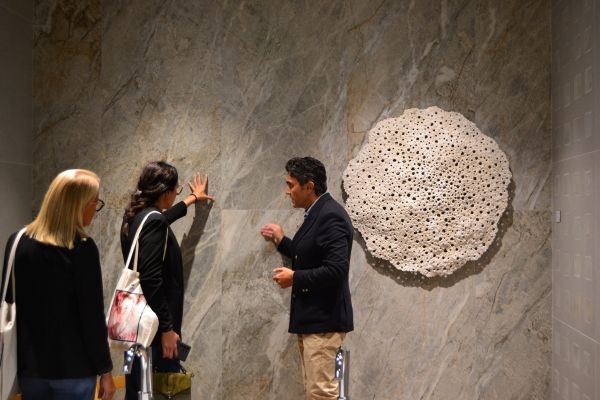
Image courtesy Cersaie
By Arpi Nalbandian Tileometry
The international tile event Cersaie serves annually as the launching pad for inspiration, innovation, and imagination. Together with its already-established reputation, this year’s edition continued to deliver the unexpected and surprises. Presenting elevated design options with one of earth’s oldest decorative building materials, the 41st edition of Cersaie in Bologna, Italy, on Sept. 23-27, upended any previously held expectations by diving into experimental, and at times philosophical possibilities, that can be utilized with ceramic or porcelain material. Cersaie reaffirmed its role as a unique global platform where businesses showcase their latest creative innovations thanks to expansive and visually dynamic booths. Although attendance was slightly lower than the 2023 event (4%), Cersaie 2024’s footprint spanned 15 fully occupied halls with a total floor space of 145,000 m² comprised of 606 companies, including 332 from the ceramic-tile sector.
Geometric Wonders
Geometry and handmade tile nurtured a symbiotic relationship for centuries, and that relationship continually aims to reach higher aspirations. The shapes may look familiar, but how they’re organized, placed, or angled makes a difference whether something that looks like business as usual, or something that beseeches you to come take a closer look. By evoking a litany of emotions – as a focal point that reinforces a specific look or mood or complementing the overall feel of serenity – geometric tile checks all the boxes.
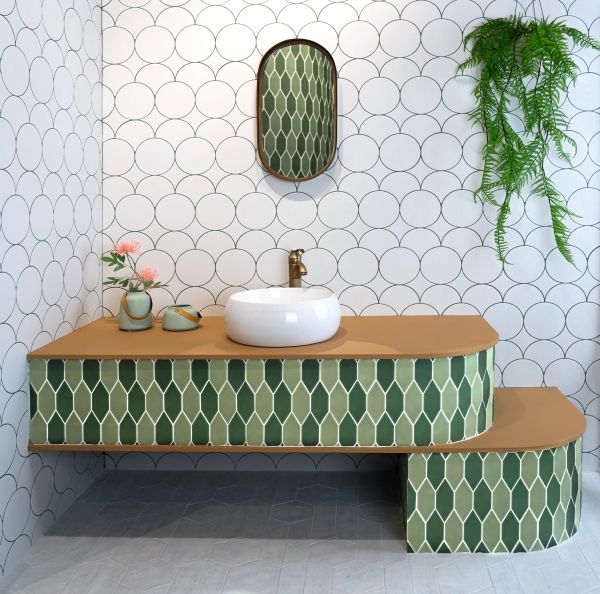
Cobsa’s Japandi collection, shown on the wall in the White Latte option, is accentuated with multi-colorful geometric patterned tile. (Image courtesy Tile of Spain).
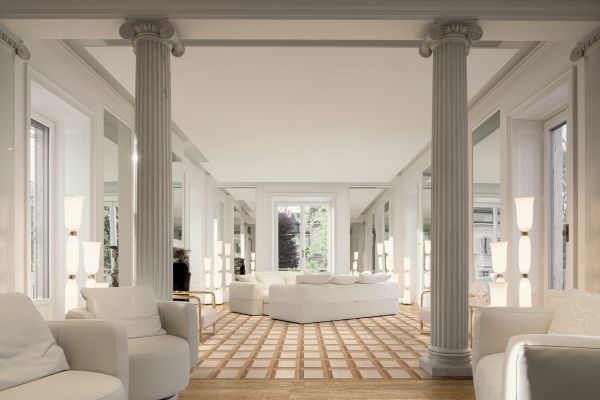
Timeless parquet flooring is recreated with two of Versace Ceramics’ latest tile introductions – V Stone and Leatherwood. V Stone evokes materials found within Palazzo Versace; the Leatherwood series that emulates the textures and aesthetic qualities of wood and leather. (Image courtesy Versace Ceramics)
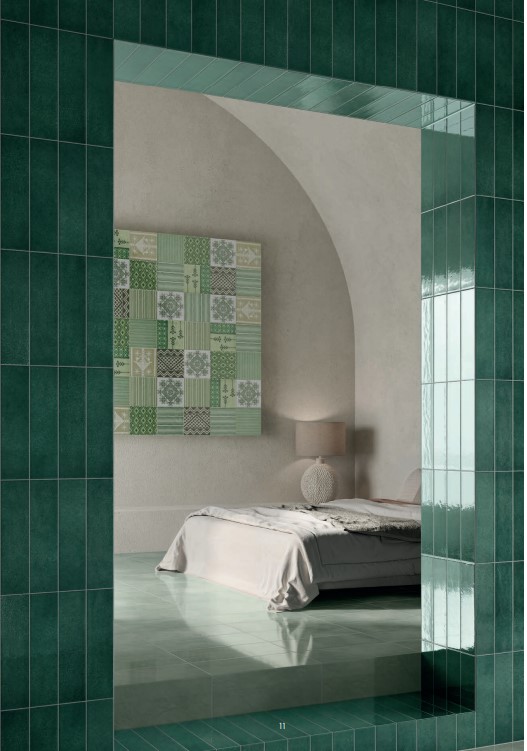
Cerasarda’s newly unveiled tile series, Costa Dorata, celebrates Sardinian imagery; 10 unique solid colors in this series effortlessly reflect calming light. (Image courtesy Cerasarda}
Earthy: Clay, Terrazzo, Terracotta
Tile combines the simple materials of clay, minerals and water. Isn’t a wonder how seven steps – mining, blending mixing, drying, pressing/extruding, glazing, and firing – evolve into a material capable of serving multiple purposes, including the ability to change the feeling or function of an area (think spas, hygienic rooms).
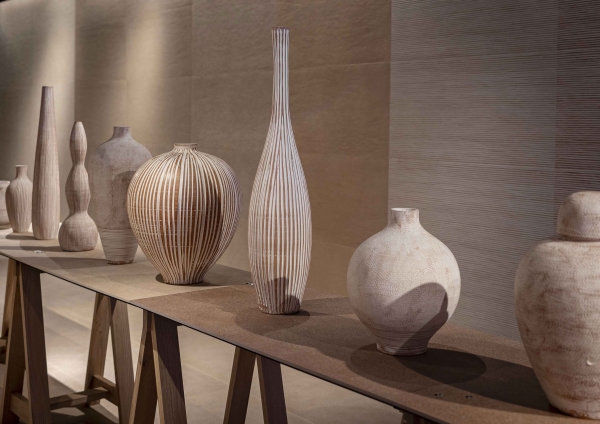
The collaboration between Florim and Matteo Thun grows stronger with the SensiTerre collection, a porcelain coverings project that “reimagines the world of clay, combining craftsmanship with technological innovation.” (Image courtesy Florim)
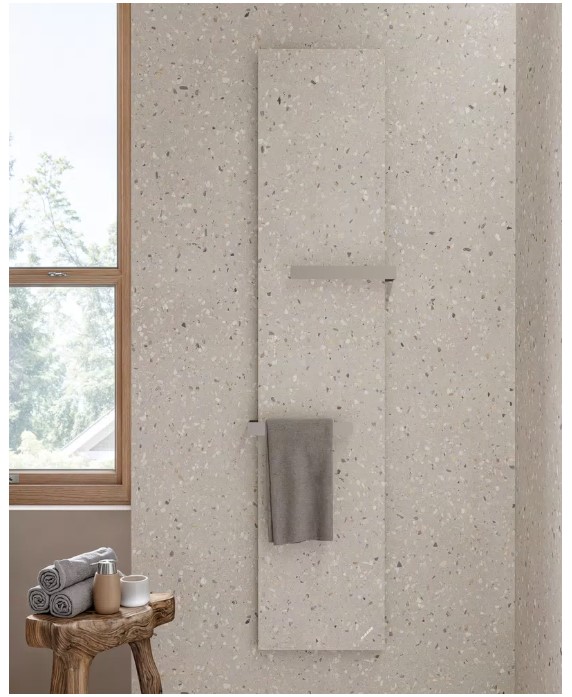
Mirage continues to emphasize its commitment to sustainability with its new ReConcrete project. This second offering of the ReSource product family integrates more than 60% pre-consumer recycled materials into our collections, combining production efficiency with innovation in porcelain stoneware surfaces. ReConcrete is offered in eight color variations. (Image courtesy Mirage)
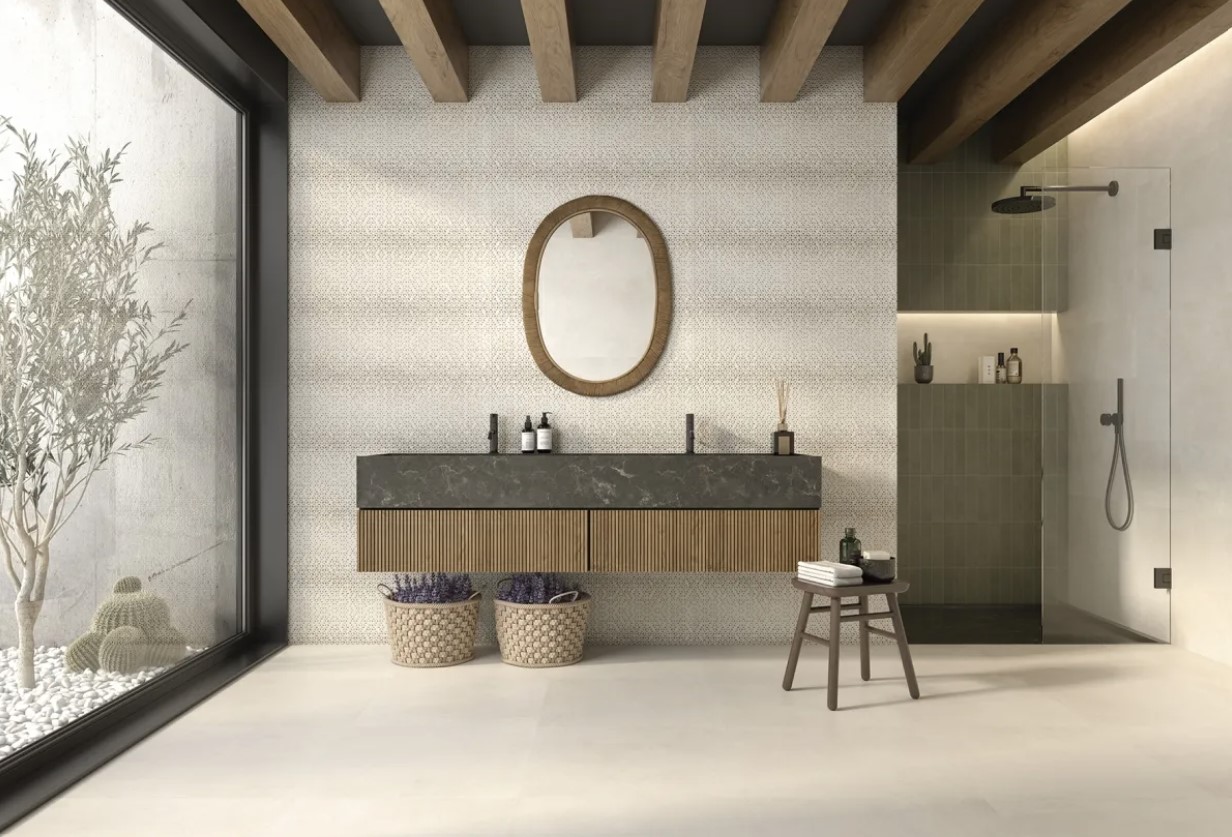
Keraben’s new and aptly named Terracotta collection includes the Art series, a matte rectified 10mm-thick porcelain wall tile measuring 30cm X 90cm that eloquently recreates the look of handmade terracotta wall coverings. Available in two colors – Cemento and Barro.( Image courtesy Keraben)
Hypnotic & Linear
In geometry, a line is a basic element used to create more sophisticated, complex shapes. Without the humble line, the transformation into triangles, circles, squares, polygons, and more wouldn’t be possible. As fundamental as it is, the modest line takes on different facets, thanks to the innovations sampled here at Cersaie.
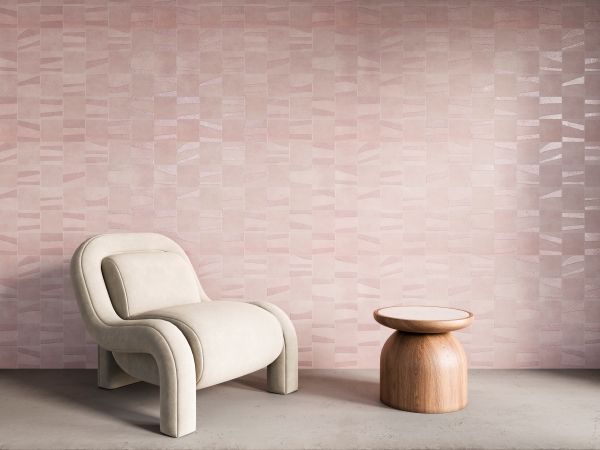
With the introduction of Horizon, Decocer represenst the reflections of particles found in beach sand mixed with remains of shells, gold, and other minerals. On a matte base, colored scales appear in random patterns, reflecting on the ceramic surface and making each piece unique. The collection, produced from porcelain stoneware, is available in a square format (15cm X 15cm) in eight autumnal colors. (Image courtesy Decocer)
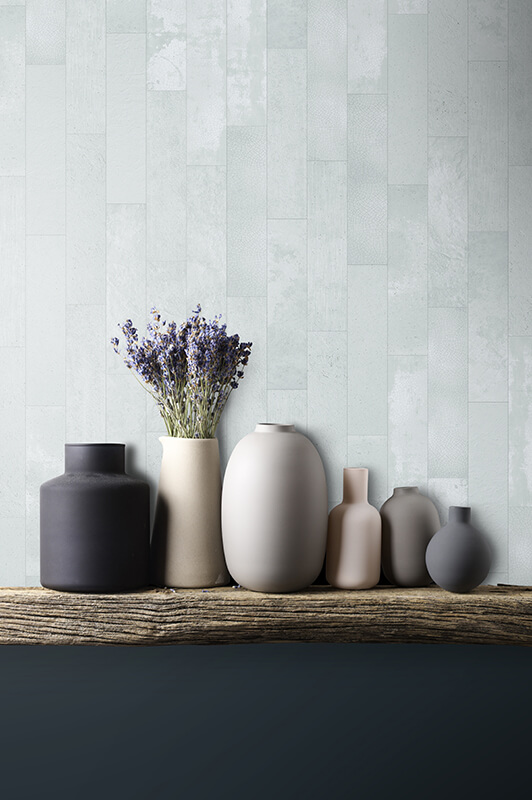
From Sottocer is the Fusion wall tile collection. Offered in seven earthy shades (Coco, Sienna, Ghost, Lake, Sage, Desert, and Dune) in a 5cm X 25cm X 0.87cm format. (Image courtesy Sottocer)
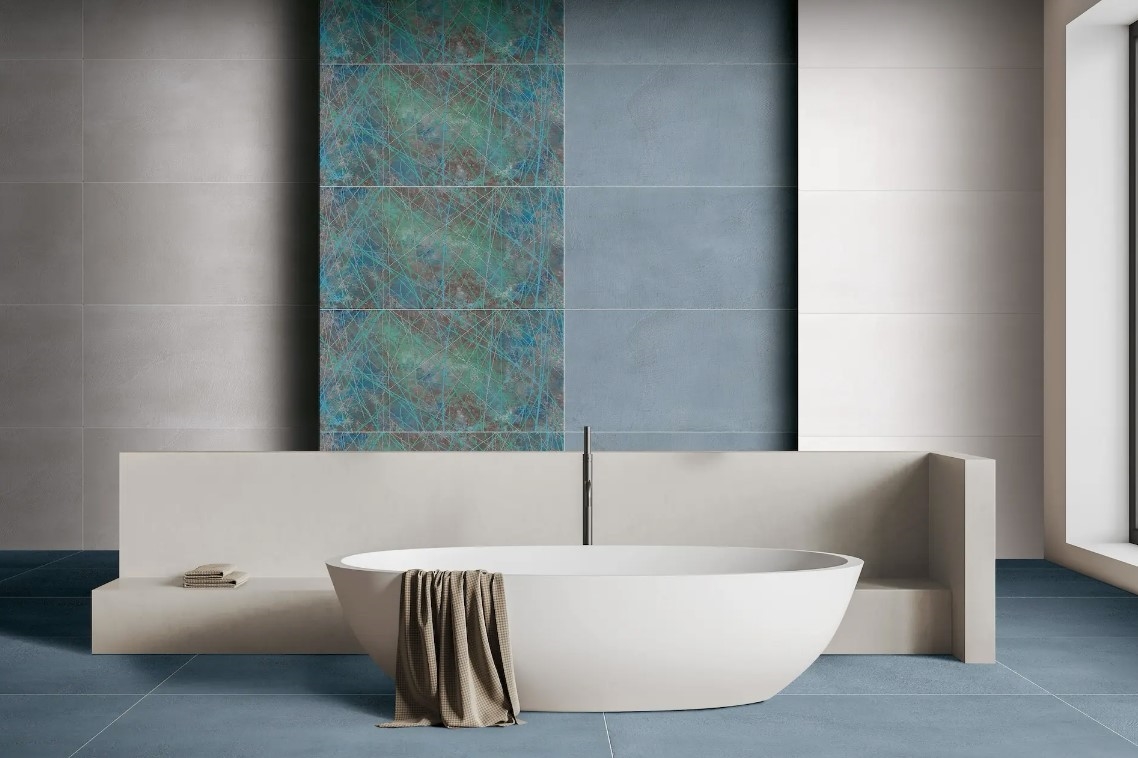
Ceramiche Brennero’s Le Malte series of porcelain tile adapts to various settings and materials, thanks to DigiTech high fidelity printing technics and technology. (Image courtesy Ceramiche Brennero)
Technology & Biomimicry
Biomimicry can significantly enhance technology and innovation in kitchens and bathrooms with ceramic- or porcelain-tile slabs replicating the appearance of natural stone while supplying the inherent aspects of tile (sustainability, longevity, thermal hygienic and health & wellness) – as well as pleasing patterns, tactile textures, and enhanced form/function.
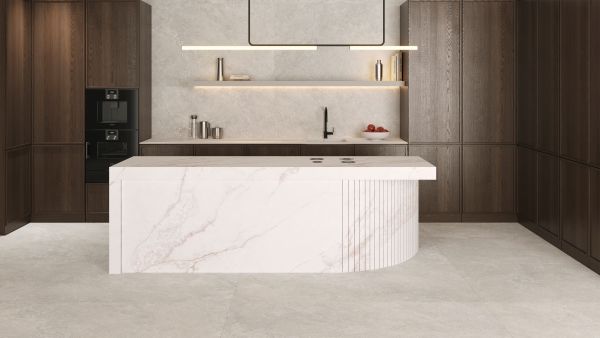
Dahlia from Museum Surfaces, inspired by Turkish Breccia, reproduces white marble streaked with grey veinsand interlinked with shades of cream and beige, and further embellished by subtle hints of pink. (Image courtesy Museum Surfaces)
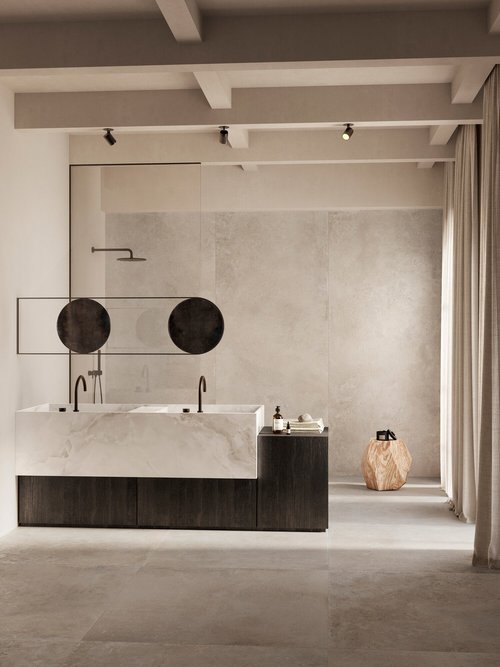
Ascot Gruppo Ceramiche’s latest large format porcelain tile panel, Slabs, is a rectified glazed porcelain panel collection measuring 120cm X 280cm (48"x110"). Offered in 10 various nature-inspired graphics – marble, wood, stone, and cement – the material is suitable for walls, sinks, kitchen islands and countertops, and more. (Image courtesy Ascot Gruppo Ceramiche)
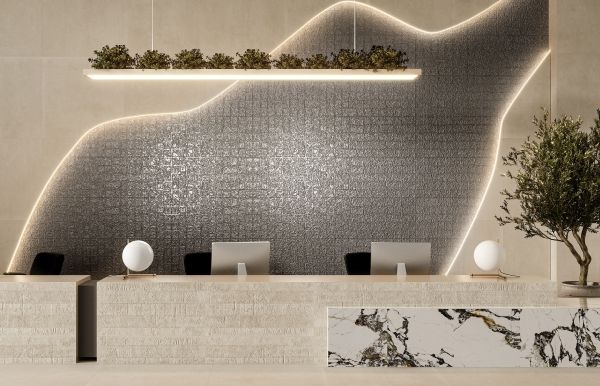
By combining tile with innovative lighting technology, architects and designers can create beautiful, functional spaces. Backlit tile panels, integrated LED strips, smart lighting solutions, and sustainable lighting options enhance both the visual appeal and usability of kitchens and bathrooms. Here’s a chameleon-like example by Ceramicas Aparici. (Image courtesy of Tile of Spain)
Ventilated Façades, Accessibility
Without technology and innovation, the ventilated façade would not be enjoying their moment in the sun, so to speak. Thanks to research and the development of energy-efficient manufacturing, ventilated façades have seen an increase in being specified for large-scale projects – specifically, retrofits for existing structures. On the other hand, large tile panels shouldn’t only be limited to vertical applications. They can also be used horizontally to offer robust accessibility in areas where traditional options are either impractical, more-expensive, or required time-consuming installation processes.
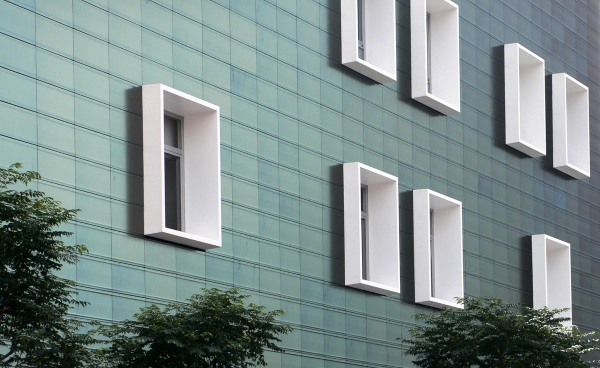
Faveker unveiled its latest solution in providing energy-efficient ventilated façades clad with extruded ceramic tiles. These systems allow for energy savings of up to 40% thanks to thermal insulation and high-performance properties, while offering a 48%-recycled-content product. The company states that the façade systems can be fully recycled, a key factor in circular economy building criteria. (Image courtesy Faveker)
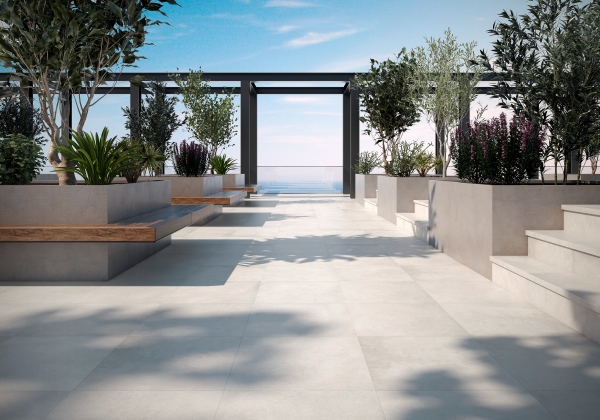
Urban20mm from Gres Aragón is a 20mm-thick porcelain tile where the depth makes it highly resistant and suitable for a myriad of uses. The series, offered in a 60cm X 60cm format in a range of whites, greys, and beiges, can be used indoors or ou, in raised-access floor systems, or laid directly atop grass, sand, or gravel. Further, it can withstand wheeled traffic, making it optimal for terraces, parks, swimming pools, beachside areas, and more. (Image courtesy Gres Aragón)
Finally, with hundreds of newly unveiled ceramic and porcelain tile products showcased during this year’s edition of Cersaie, it’s difficult to capture all the splendor in one article. Your best bet for more news and information? Visit the Cersaie website to get a glimpse, or make sure to attend next year’s event in in Bologna from September 22-26. Ciao!